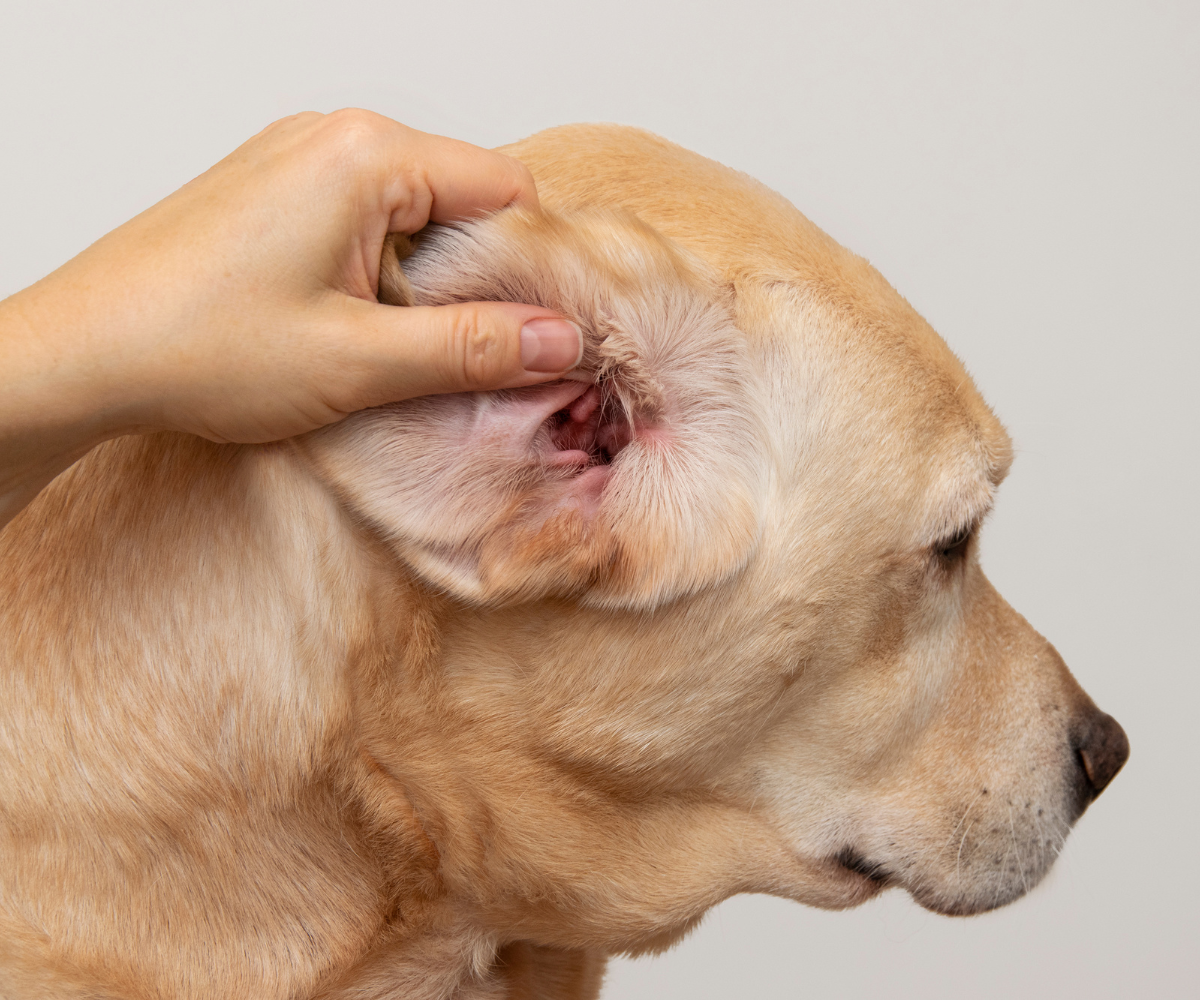Dog Ear Mites vs Ear Wax: What Is the Difference?
Dog Ear Mites vs Ear Wax: What Is the Difference?

Vet Reviewed

By: Sarah Hodgson
March 5, 2024
Table of Contents
Dog ear mites and ear wax can both be found in a dog's ear canal, but they are two very different things. Ear mites are tiny external parasites that can cause a lot of discomfort for your furry friend, while ear wax is a natural substance produced by the ear canal's glands. It's important to know the difference between the two so that you can properly diagnose and treat any ear issues your dog may have. In this article, we'll explore just that the difference between ear wax and mites.
Let's dive in!
What Are Ear Mites?
Ear mites are a common parasitic infection in dogs that can cause severe itching, inflammation, and pain. These tiny parasites, scientifically known as Otodectes cynotis, can be seen under a microscope and are usually transmitted from one dog to another through direct contact.
Identifying Ear Mites
One of the most distinctive signs of ear mites in dogs is the presence of black, coffee ground-like discharge in the ear canal. This discharge is a result of the mites' fecal matter and can have a strong, unpleasant odor. Dogs with ear mites may also scratch their ears excessively, shake their heads, and show signs of discomfort when their ears are touched.
Symptoms of Ear Mites in Dogs
In addition to the black discharge and scratching, ear mites can cause inflammation and redness in the ear canal, leading to pain and discomfort. If left untreated, this can result in secondary bacterial infections and further complications. It is important to seek veterinary care if you suspect your dog has ear mites.
Treatment Options for Ear Mites
Ear mites can be treated with a variety of medications, including prescription ear drops and topical ointments. Selamectin and fluralaner are two commonly prescribed medications for ear mites. These medications can kill both the adult mites and their eggs, helping to prevent further infestations. It is important to follow your veterinarian's instructions carefully and complete the full course of treatment to ensure that the infection is completely eradicated.

What Is Dog Ear Wax?
Ear wax, also known as cerumen, is a yellowish-brown, moist substance that is naturally produced by the ear canal. It plays an important role in protecting the ear canal from debris, dust, and other foreign particles. Ear wax also helps to lubricate the ear canal, preventing dryness and discomfort.
Common Signs of Ear Wax Buildup
While ear wax is important for ear health, excessive buildup can cause discomfort and even infections. Signs of ear wax buildup in dogs include a strong smell, yellow or light brown color, and a moist texture. Dogs may also scratch their ears frequently or shake their head in an attempt to relieve discomfort.
Safe Removal of Excessive Ear Wax
If a dog has excessive ear wax buildup, it is important to safely remove it to prevent discomfort and infections. The safest way to remove ear wax is to use a cotton ball or soft cloth dampened with an ear cleaner specifically designed for dogs. It is important to avoid using cotton swabs or other objects that may push the ear wax further into the ear canal, causing more harm than good.
To remove ear wax, apply the ear cleaner to the cotton ball and gently massage the ear canal. This will help to loosen and remove the excess wax. Use a clean cotton ball to wipe away any remaining wax and debris. It is important to avoid using too much pressure or force when cleaning the ear, as this can cause discomfort and even damage to the ear canal.
The Difference Between Ear Mites and Ear Wax
Ear mites and ear wax are two common ear problems that dogs can experience. Understanding the difference between the two can help dog owners provide appropriate treatment and care for their furry friends.
Ear Mites
Ear mites are tiny external parasites that can cause severe itching, inflammation, and irritation in a dog's ear canal. They can be transmitted from one dog to another through direct contact or by walking through an area where the mites live. Some common symptoms of ear mites in dogs include:
- Frequent head shaking
- Rubbing of the ears
- Black, coffee ground-like discharge from the ears
- Redness and swelling of the ear canal
If you suspect that your dog has ear mites, it is essential to take them to a veterinarian for proper diagnosis and treatment. The veterinarian may use an otoscope or microscope to examine the ear canal and identify the presence of ear mites. Treatment typically involves cleaning the ears and administering medication to kill the mites.
Ear Wax
Ear wax is a natural substance produced by the ear canal's glands to protect the ear from dirt, debris, and infection. In most cases, ear wax is harmless and can be cleaned regularly to prevent buildup. However, excessive ear wax can cause an infection if not cleaned properly. Some common symptoms of excessive ear wax in dogs include:
- Yellowish discharge from the ears
- Redness and swelling of the ear canal
- Foul odor from the ears
If you suspect that your dog has excessive ear wax, it is essential to take them to a veterinarian for proper diagnosis and treatment. The veterinarian may use an otoscope to examine the ear canal and identify the presence of excessive ear wax. Treatment typically involves cleaning the ears and administering medication to prevent infection.
Complications and Secondary Infections
Ear mites can cause a variety of complications and secondary infections in dogs. One of the most common complications is ear infections, which can be caused by the irritation and inflammation that ear mites create. The presence of ear mites can lead to a buildup of wax and debris in the ear canal, which can create an ideal environment for bacteria, yeast, and fungi to grow. This can cause an infection known as otitis externa, which can be painful and lead to pus and swelling.
In addition to ear infections, ear mites can also cause inflammation in the ear canal. This inflammation can lead to redness, itchiness, and discomfort for the dog. If left untreated, it can also lead to damage to the eardrum and other complications.
Impact on Overall Pet Health
Ear mites can also have an impact on the overall health of the pet. If left untreated, ear mites can lead to chronic ear infections, which can cause permanent damage to the ear canal and eardrum. This can lead to hearing loss and other complications.
Furthermore, ear mites can be a sign of underlying health issues, such as allergies or immune system disorders. It is important to address ear mites promptly and thoroughly to prevent these complications and ensure the overall health of the pet.

Preventing Ear Problems in Dogs
Dogs are prone to ear problems, but there are steps that can be taken to help prevent them. Regular ear care and monitoring, along with environmental and lifestyle factors, can help keep your dog's ears healthy.
Routine Ear Care and Monitoring
Routine ear care is essential to maintain healthy ears in dogs. This includes cleaning the ears regularly to remove any excess wax or debris. It is important to use a gentle ear cleaning solution recommended by a veterinarian and to avoid using cotton swabs, as they can push debris further into the ear canal.
In addition to cleaning, it is important to monitor your dog's ears for any signs of irritation or infection. This includes checking for redness, swelling, discharge, or a foul odor. If any of these symptoms are present, it is important to consult a veterinarian for proper diagnosis and treatment.
Environmental and Lifestyle Factors
Environmental and lifestyle factors can also play a role in preventing ear problems in dogs. Providing shade and avoiding physical contact with other dogs can help prevent injuries and the spread of infections. Certain breeds, such as Cocker Spaniels, are more prone to ear problems due to their sensitive ears. Regular visits to a veterinarian can help identify any potential ear problems and provide guidance on proper care.
The Bottom Line
So there you have it. dog ear mites and ear wax may look similar, but they are two very different things.
If you suspect that your dog has ear mites, it's important to take them to the vet for a diagnosis and appropriate treatment. Ear mites are highly contagious and can easily spread to other dogs. Your vet may prescribe medication to kill the mites and reduce inflammation in the ear.
On the other hand, if your dog has excess ear wax, it's generally not a cause for concern. However, if you notice an unusual amount of wax or a change in color or consistency, it's worth taking your dog to the vet to rule out any underlying health issues.
Frequently Asked Questions
How can you distinguish between an ear mite infestation and a wax buildup in a dog's ear?
Ear mites and wax buildup in a dog's ear can have similar symptoms, such as itching, discharge, and inflammation. However, ear mites can be identified by the presence of dark granules resembling coffee grounds in your dog's ears, which are not present in wax buildup. If you notice these granules, it is important to take your dog to the vet for proper diagnosis.
What are the signs and symptoms of ear mites in dogs?
The signs and symptoms of ear mites in dogs include itching, shaking of the head, discharge, inflammation, and a strong odor. You may also notice dark granules resembling coffee grounds in the ears. If you suspect that your dog has ear mites, it is important to take them to the vet for proper diagnosis and treatment.
What treatment options are available for ear mites in dogs?
There are several treatment options available for ear mites in dogs, including topical medications, oral medications, and ear drops. Your vet will recommend the best treatment option based on the severity of the infestation and the age and health of your dog.
How can I differentiate between ear mites and a yeast infection in my dog's ears?
Dog ear mites and yeast infections have similar symptoms such as itching, discharge, and redness. However, a distinctive characteristic of ear mites is the presence of dark granules resembling coffee grounds in your dog's ears, which are not present in yeast infections. Other symptoms of ear mites include reddish ear wax and swelling.
Are there any particular characteristics of ear discharge that indicate ear mites rather than just dirty ears?
Ear mites produce a dark, granular discharge that resembles coffee grounds, which is a distinctive characteristic of an ear mite infestation. If you notice this type of discharge in your dog's ears, it is important to take them to the vet for proper diagnosis and treatment.

Subscribe to Petfluence!
Get updates on the latest posts and more from Petfluence straight to your inbox.